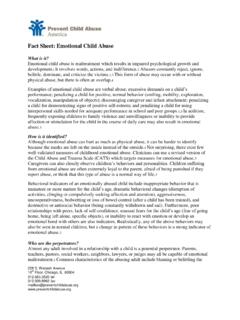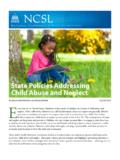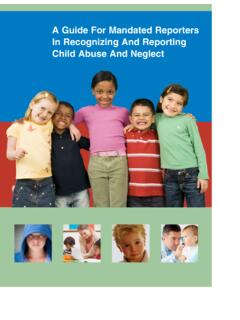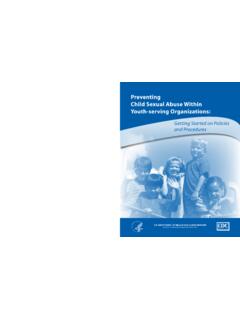Transcription of Sexual abuse of boys - Prevent Child Abuse America
1 228 S. Wabash Avenue 10th Floor, Chicago, IL 60604 tel fax Fact Sheet: Sexual Abuse of boys What is it? The definition of Sexual Abuse varies among researchers1 and has led to much Some characteristics that are used include the age difference between the perpetrator and the victim, existence of coercion, victim s reaction, involvement of an authority figure, existence of physical contact, and existence of penetration. Age differences can be grouped into three different categories: first, the abuser is an adult (18 years or older) and the victim is a Child (under the age of 18); second, the age difference between the abuser and victim is a set number (usually 5 or more years), regardless of victim age; or third, the age difference between the abuser and victim varies with the age of the victim (usually, a 5 year difference if the victim is younger than 13 years, a 10 year difference if the victim is between ages of 13-16, etc.)
2 Negative reactions from the victim (either immediately or retrospectively) about a Sexual experience are sometimes used to define Sexual Abuse . Penetration usually refers to anal penetration of the victim or anal or vaginal penetration of the perpetrator by the Another form of Child Sexual Abuse is in the making and use of Child How much do we know about it? Sexual Abuse of boys is common, underreported, under-recognized, and under-treated. Sexual Abuse of girls has been widely studied, leading to awareness of the risk factors and prevalence. Unfortunately, there have been relatively fewer studies done on Sexual Abuse of boys , leading to inadequate knowledge about the facts related to this topic.
3 Some of the studies that are available have a high degree of subjectivity, poor sampling techniques, and poor designs with few control Underreporting is a result of many boys are less likely than girls to report Sexual Abuse because of fear, the social stigma against homosexual behavior, the desire to appear self-reliant ( boys grow up believing that they should not allow themselves to be harmed or talk about painful experiences)4, and the concern for loss of Furthermore, evidence suggests that one in every three incidents of Child Sexual Abuse are not remembered by the adults who experienced them, and that the younger the Child was at the time of the Abuse , and the closer the relationship to the abuser, the more likely one is that the Child will not be able to recall the How common is it?
4 Though rates are likely to underestimate the actual number of Sexual Abuse cases in boys , approximately one in six boys is sexually abused before age The prevalence estimates vary widely (ranging from 4%-76%) because of differences in the definitions used and populations studied. This type of Abuse is also related to concurrent physical Abuse . 228 S. Wabash Avenue 10th Floor, Chicago, IL 60604 tel fax Who are the victims? Any boy (across the sociodemographic spectrum) can be a target of Sexual ,4 However, there exist factors that may place boys in a higher risk group.
5 boys at highest risk for Sexual Abuse are those younger than thirteen years of age, who are nonwhite, are of low socioeconomic status, and who are not living with their fathers. One study also suggests that disabled boys are also at increased risk. Family factors may also contribute to an increase in risk. These factors include living with only one or neither parent; parental divorce, separation, or remarriage; parental alcohol Abuse ; and parental criminal Sexually abused boys are also more likely than nonabused boys to have other family members who are also sexually or physically ,4 Those abused by a family member are at highest risk of concurrent physical Interestingly, there are also family factors that may decrease the risk of Sexual Abuse in adolescent boys .
6 One study found that maternal education and parental concern are protective Who are the perpetrators? Sexual abusers of boys tend to be males1,4 who are known by the victim, but unrelated to the They tend to Abuse the Child outside the home1,4, repeat the Abuse , and involve some form of But, females can also be the perpetrators ( boys are more likely than girls to be abused by a female)4 and tend to use persuasion rather than force or the threat of force. Threats of physical force or actual force are more common with male perpetrators and older What are the effects? Although boys are more likely to be physically injured than girls during a Sexual assault6, physical signs of Abuse may not exist and are usually only found within a short time period after the incident.
7 These physical sequelae may include anal redness, abrasions, lacerations, evidence of sperm, or sexually transmitted diseases (including HIV). boys younger than 2 years of age are most likely to have physical Silence about this type of Abuse is very common. Many victims feel that they want to forget about the event, want to protect the perpetrator, and fear the reactions by those told about the Abuse . Those who choose to disclose details of Abuse may also find that few resources are available to provide support or few actions are taken. In one study, only 56% of valid intra-familial Sexual Abuse cases reported to a protective services unit involved the police.
8 Perpetrator imprisonment occurred in 16% and victim removal from the abusive home occurred in 4% of these cases. Moreover, only 56% of these victims were referred for mental health treatment, and only half of those referred actually received Negative sequelae are prevalent and may lead to boys re-enacting the Abuse by abusing other children6 or becoming future Child Sexual abusers The outcomes of Sexual Abuse of boys can fall into three main categories: psychological distress (posttraumatic stress disorder, 228 S. Wabash Avenue 10th Floor, Chicago, IL 60604 tel fax major depression, anxiety disorders, borderline personality disorder, antisocial personality disorder, paranoia, dissociation, somatization, bulimia, anger, aggressive behavior, poor self-image), substance Abuse , and sexually related problems ( Sexual dysfunction, hypersexuality, sexually aggressive behavior, and confused Sexual identity)1,6.
9 These outcomes may lead to poor school performance, running away from home, and legal Studies have indicated that sexually abused boys and girls have significantly more emotional problems, behavioral problems, and suicidal thoughts and attempts than their non-abused In addition, it seems that the experience of Sexual Abuse has more severe and complex consequences for boys than for girls in respect to emotional and behavioral problems (extreme use of alcohol and drugs, aggressive/criminal behavior, poor school performance, truancy, and Sexual risk taking).5,7,8 It was found that female adolescents tend to engage in internalizing behaviors while males adolescents engage in externalizing What can be done?
10 Increased awareness for and research in the topic of Sexual Abuse in boys is needed. Research is specifically needed in evaluation of victims, management strategies for the victims, and in studying women as perpetrators. Future studies should also make an effort to include better methods of obtaining Sexual Abuse histories, better definitions of Abuse , improved sampling, more extensive data collection, and more sophisticated analyses. In addition, health care professionals should become more educated in this topic and more sensitive to the possibility of Sexual Abuse in their male Therapy for the victims include reducing or preventing the negative effects from occurring, helping the victim in achieving normal development for his or her age, and preventing further Abuse from occurring or being unreported.











